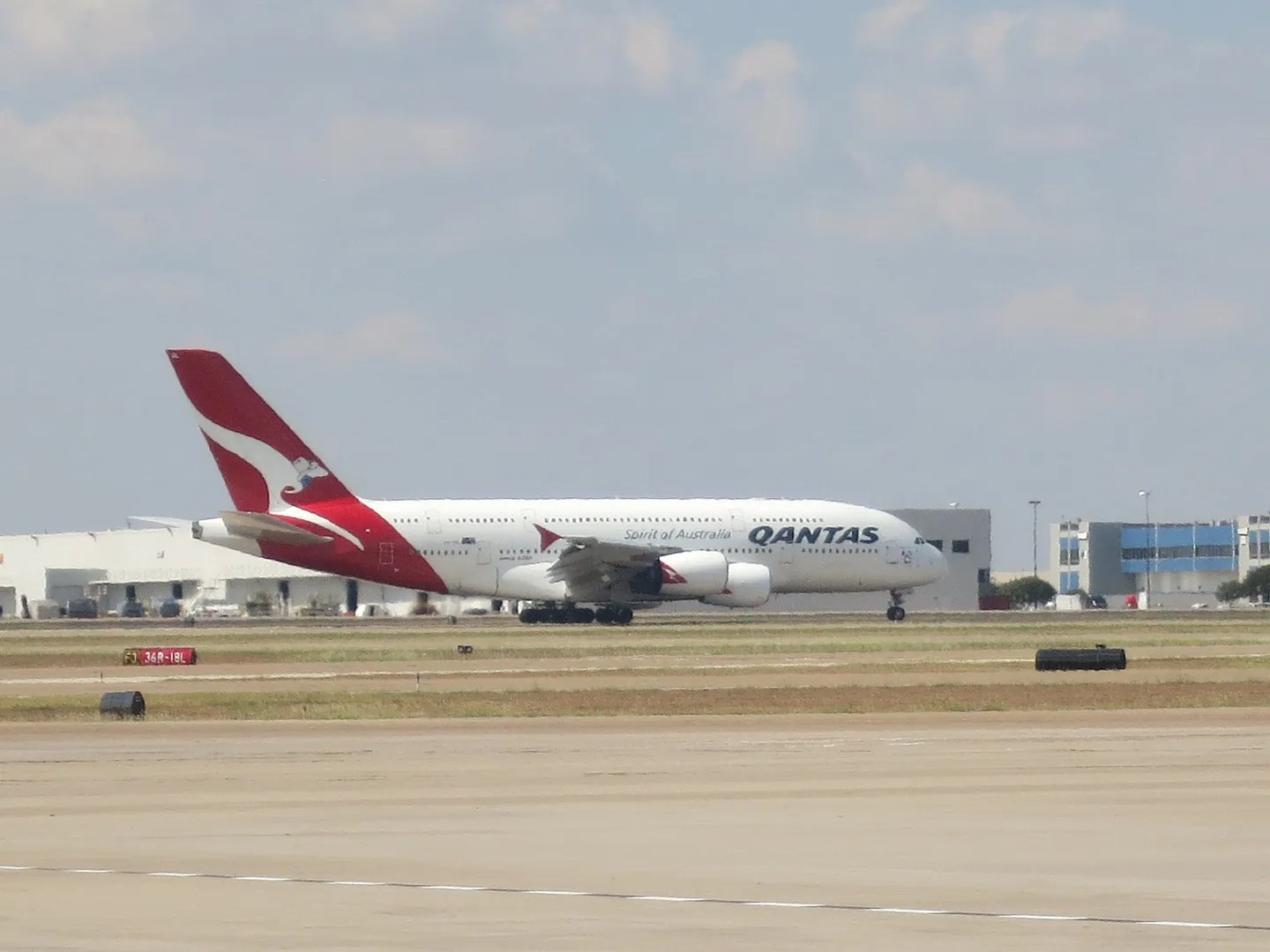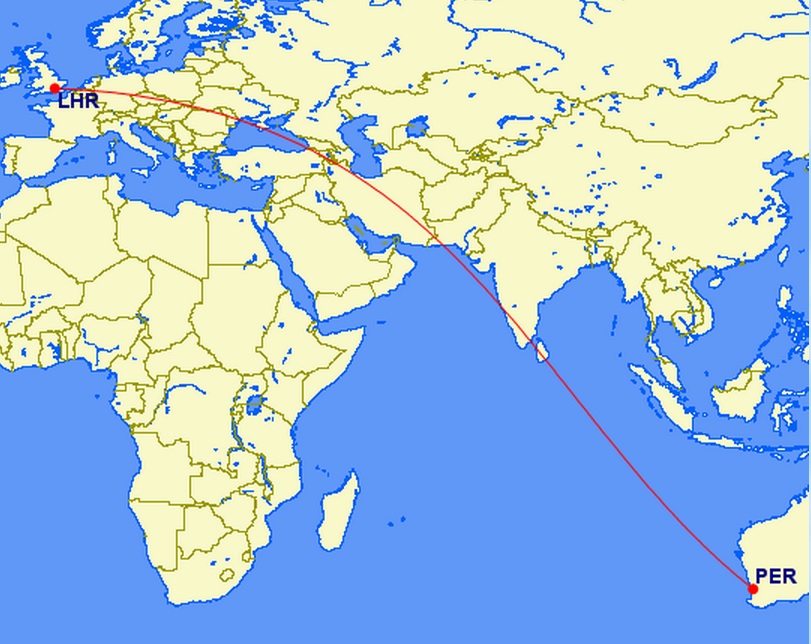Qantas flies what used to be the longest flight in the world, Sydney – Dallas, with an Airbus A380.

I flew first class on the airline’s big bird Sydney – Los Angeles and have an upcoming award booked for Dubai – Sydney which is a pretty long flight as well.

The past 18 months have seen plenty of speculation of new routes longer than Dallas – Sydney:
- Emirates was supposed to launch Dubai – Panama City operated by a Boeing 777-200LR but postponed the route.
- Air India considered topping that with San Francisco – Bangalore but ultimately announced San Francisco – Delhi instead.
- Both China Airlines and EVA Air are considering Miami service which would be 63 miles longer than Dubai – Panama city.
The current world’s longest flight exceeds all of those: Emirates Dubai – Auckland at 8824 miles.
And at the end of January that will be surpassed by Qatar’s Doha – Auckland service operated by a Boeing 777-200LR, clocking in at 9032 miles.
For the past year Qantas has been talking about their own flight that tops Dubai – Auckland: Perth, in Western Australia, to London with a new Boeing 787-9 in late 2017.

And they’re expected to announce it tomorrow:
With Qantas boss Alan Joyce set to fly to WA tomorrow to make an announcement alongside airport chiefs and Premier Colin Barnett, it is understood the airline and Perth Airport are close to finalising the landmark agreement.
The development would pave the way for direct flights from Perth to London using Qantas’ revolutionary Boeing 787 planes, with the potential for extra routes to Paris, Frankfurt and Rome to follow.
Qantas is expected to take delivery of its first Boeing 787, which will be capable of flying between Perth and London in 171/2 hours, late next year.
Here’s the thing:
- I calculate it at 23 miles shorter than Doha – Auckland.

- It still wouldn’t be the longest scheduled commercial flight ever, as it’s 500 miles shorter than Singapore Airlines’ former Newark – Singapore route. Singapore Airlines is expected to return to New York (and Los Angeles) when Airbus completes and delivers the ‘ultra long range’ version of its A350.
Here’s why it will be the longest flight in operation at the time of launch (even if only briefly until Singapore returns to New York): while the great circle routing for Perth-London is shorter than Doha-Auckland, Qantas won’t fly precisely direct. They’ll divert slightly to avoid Crimea and the actual flight distance will be marginally greater.
Why Perth? It’s a whole lot shorter than the traditional ‘Kangaroo Route’ Sydney – London.

I think that connections from Australia to European destinations are better-served via Dubai with their partner Emirates and a London direct flight would be most valuable only to passengers with London as their final destination. Why overfly whatever European city you’re headed to, and be forced to connect at Heathrow?
The 787’s crew rest area will certainly get use on such a long flight.


Crew rest onboard American Airlines Boeing 787-8
Qantas could fly the Boeing 787-9 Sydney – Chicago and that’s an even longer flight than Perth – London Heathrow. However that’s not going to happen without their American Airlines joint venture that the Department of Transportation rejected.
The longest flight I’ve ever taken is Los Angeles – Abu Dhabi. It’s long, but doesn’t feel materially longer than New York JFK – Hong Kong or even New York JFK – Abu Dhabi. Long flights are long flights, the last couple of hours aren’t noticeable to me at least in premium cabins.
(HT: One Mile at a Time)


I did the old EWR-SIN flight and it wasn’t too bad. What made my trip bad was that My whole routing that trip was EWR-SIN-PER and then PER-SIN-LAX-ORD, all for 27 hours in Perth to do a presentation.
Fun, but exhausting.
Someone needs to announce LHR-AKL non-stop.
THAT will be the world’s longest route.
I guess folks care what the longest flight is for “trivia” reasons. I flown a lot of them, and don’t really care which is actually the longest. I like the flights because they save me time and trouble (no stops).
That said, the ultra long flight times are really more of an issue in coach than in premium classes. That’s because it can be physically difficult to sit for more than 12 hours in a coach seat (other than boredom, there’s really no comfort issues up front). When Continental launched its first polar flights from EWR to Asia, there was some uncertainty whether coach passengers would be willing to sit that long. The company dubbed these “sore fanny flights.” I can attest to the truth of this: if I’m in coach, my butt does sometimes hurt on the ultra long flights. It’s certainly the time when coach seat comfort matters the most. From my experience, some coach seats are better than others. And I think newer seats tend to be better than older seats (maybe they “wear out” a bit?).
This kind of route is what the 787 was truly designed for.
A good point for coach passengers and the length of time in their seats, as DVT then remains an ever increasing threat that infrequent flyers just are not aware of. Especially older passengers who, it appears to me anecdotally, are traveling more and more.
> Qantas could fly the Boeing 787-9 Sydney – Chicago and that’s an even longer flight than Perth – London Heathrow. However that’s not going to happen without their American Airlines joint venture that the Department of Transportation rejected.
That could not be further from the truth. QF continues to have the preexisting partnership and ability to codeshare with AA, so *if* the traffic is there they will still put the flight to ORD and beyond (i.e. you will be able to fly Peoria-Sydney all on QF code or AA code).
What the DOT blocked is AA and QF merging the transpacific business into a single virtual operation with 60% market share (and growing), a pretty scary proposition for customers. Imagine the prices! Thanks to the DOT they can’t make decisions together and each airline’s transpacific operation needs to make sense on its own, even if it competes against the other’s. And since AA is getting 787-9s, they could be the ones starting ORD-SYD, beating QF.
@Paul they can still partner (they have a frequent flyer program partnership) and even codeshare but the previous joint venture they had from 5 years ago is no help with this.
There’s nothing scary for consumers about the proposed joint venture, even the DOT in denying the application didn’t think so. DOT’s position was that they didn’t see more flights that there would otherwise be in their counterfactual hypothetical of airlines operating alone. Which isn’t quite how this analysis is usually done.
Most Australians live on the east coast of Australia. PER is a small (Pop: 2 million), isolated city with some tourism worth but few world class, bucket list attractions. As an east coast of Australia resident (Sydney) I don’t get how PER-LHR direct would attract me. I can already get to LHR via DXB one-stop on an A380. Why would I want to connect in PER from a flight configured domestically onto a squishy B789 if I was traveling in coach? If anything QF should fly direct from PER to another one world hub in Europe.
Although not officially confirmed by QF – it is being reported locally that QF will stop their QF9 / QF10 MEL-DXB-LHR on a A380 in favour of the MEL-PER-LHR on a 787-9.
This represents a 50% loss in capacity on QF9 / QF10 and a 20% loss of capacity in QF metal’s Australia-LHR armoury (787-9 will have about 240 seats and A380 has 490 seats).
It looks like the PER experiment only becomes feasible by changing the QF9 / QF 10.
QF’s LHR/Europe strategy becomes ever more dependent upon the remaining 14 flights odd that alliance partner EK run between Australia and DXB and onto their various European destinations.
@iahphx For long flights in coach, inflatable seat pads like the one sold specifically for this by magellans.com are a game changer. It doesn’t magically transform coach into the most comfortable seat in the world but it makes the difference in buttlag between a 4h and 16h flight almost completely negligible. The hardness of the base seats doesn’t allow you to contort your body into a more stretched out reclined position, the edge of the seat will cut off circulation to half the veins in your legs. But with the pad that becomes possible with zero circulation issues allowing better sleep positions in a window seat with a good pillow. I had to do a series of flights NYC to Taiwan when I was younger. It took a little getting used to but, by the end, I was getting more than 10 hours of sleep per flight and felt great on arrival.